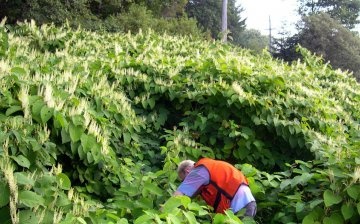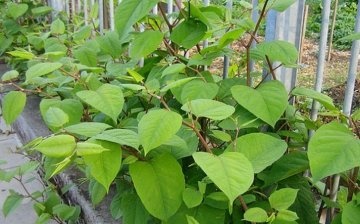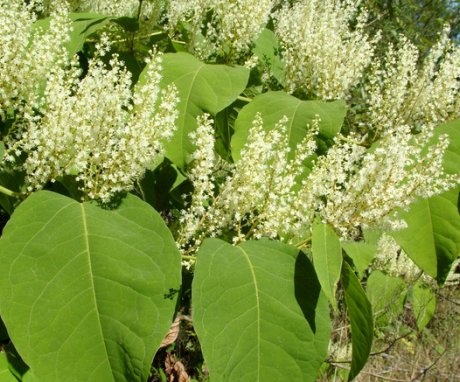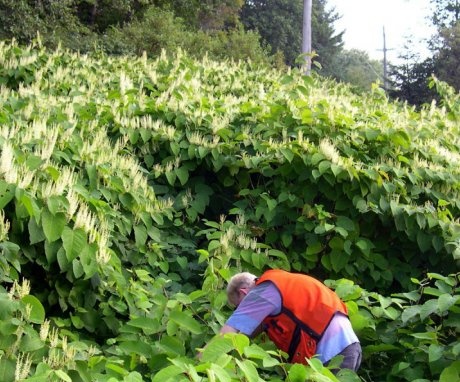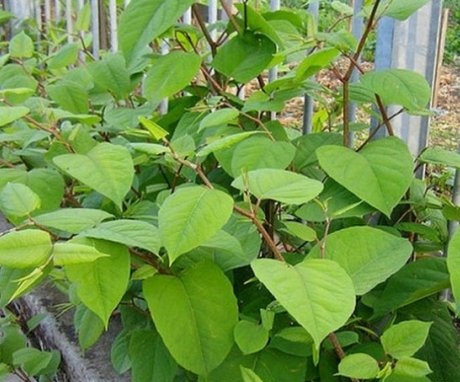Highlander Sakhalin: what harm does it cause and how to get rid of it?
How often, tempted by the unusualness of a plant, the summer resident plants it on his site. But then he does not know how to get rid of the thickets that have filled the entire area, which eventually turn into unnecessary, weed grass. At the same time, it causes great harm to other plants. Such decorative crops include Sakhalin mountaineer, or Sakhalin buckwheat.
One of the common plants Highlander grows in warm and humid climates. Ornamental grass thickets can be found on Sakhalin and the Kuril Islands. The beauty of the appearance of a perennial attracts many summer residents, and they decide to decorate their site by planting a Sakhalin mountaineer. It is interesting that the plant takes root easily and quickly becomes dominant throughout the territory.
Content:
- Features of the structure of the plant
- What harm does the plant do to the site?
- How to get rid of the weed?
- How to avoid its appearance on the site?
Features of the structure of the plant
It is not for nothing that the Sakhalin mountaineer is called buckwheat, since he belongs to the Buckwheat family. Imagine: thickets of grass with knotty stems up to two to three meters in height and leaves twenty centimeters in diameter.
Oval, heart-shaped leaves are smooth, glossy above, and covered with fluff below. On the green surface, blotches of white or pinkish are visible. The leaves are soft to the touch and tear easily.
You can either make friends with a highlander, controlling its growth, or get rid of it completely, which is very difficult.
Buckwheat is famous for its creamy small flowers collected in panicles. And the seeds of a mountaineer are triangular nuts, similar to a buckwheat grain. In the fall, the aboveground part of the plant dies off, and the rhizomes give new shoots in the spring. The creep and vitality of the horizontally located rhizome of Sakhalin buckwheat is amazing. The plant can thrive in places where the soil is humid, but severe drought will only lead to thinning of the thickets.
What harm does the plant do to the site?
Like all perennials with a creeping rhizome, Sakhalin mountaineer harms not only the plants on the site, but also the soil:
- If garden crops do not allow the roots of weeds to develop freely, then a large harvest cannot be expected.
- Vegetables or horticultural crops will be crushed by perennials and may die.
- Sakhalin buckwheat needs moist soil. If there is little moisture, then the soil is completely dried up by the plant, leaving nothing to other crops.
- The roots of the mountaineer are selected from the soil and nutrients, impoverishing it.
- Buckwheat pests migrate to vegetable and garden crops, destroying them.
The weed will take a long time to fight, so you can benefit from its growth. It is best to move the weeds to areas of the site where there is a rubbish heap or shed debris. Thus, it is possible to mask the defects of the territory. But for this it is worthwhile to shield the border of the mountaineer growth with slate, digging the material into the depth of a meter.
Buckwheat leaves will benefit those who keep rabbits. Animals enjoy the aerial part of the plant with pleasure. You can use the plant with benefit by planting it outside the fence.Sakhalin mountaineers are planted at the dump sites in order to disinfect the soil, free the soil from heavy metal salts. Even a weed plant can bring not only harm, but also benefit.
How to get rid of the weed?
It is the perennial weeds that multiply with the help of rhizomes that calmly take root on the site, not giving life to other crops. And manual weeding is indispensable here. Even a small piece of root left in the ground will give life to a new shoot. And the result of weeding is usually as follows: the more you weed, the more the Sakhalin mountaineer grows.
More effective for fighting the mountaineer herbicides... The chemical substance clehodim in the composition of the preparations will allow to destroy the thickets of the mountaineer
Only patience and continued weed control will bring a positive result.
Control the prevalence of the plant with products such as Monitor or Glyphosate. They are brought into the ground in spring or after harvesting. Will perfectly cope with the Sakhalin Highlander and Roundup. The drug is sprayed from above, and after six hours it penetrates into the plant, reaching the roots.
The weed dries up and is then removed from the soil. The herbicide Hurricane has a similar effect. Without chemicals, to combat the mountaineer, they use deep embedding of rhizomes in the ground during plowing or digging. You can get rid of the plant by oppressing it by planting dahlias.
How to avoid the appearance of weeds on the site?
It is possible to prevent the appearance of a highlander on the site. It will not appear if a decorative perennial does not grow next to neighbors or behind a fence. To avoid the appearance of highlander shoots in empty places of the territory, it is necessary to cover them with pebbles or slag, at worst with chips. Weeds do not germinate if geotextiles are used when laying paths or a yard.
Only planning the plantings and controlling their growth will help keep the site clean.
Perennial weeds develop poorly when mustard or oats are sown on the site in early spring. After them, the earth is dug up, removing dead shoots and roots.
Empty, unfilled flower beds or lawns are a great place for a highlander to grow. Therefore, it is imperative to sow bald spots with ground cover plants: cloves, loosestrife, bryozoan. They will prevent the highlander's shoots from developing.
More information can be found in the video:





